Deep Eutectic Solvents Enhance Stability of Ag/AgCl Solid State Miniaturised Reference Electrode
Abstract
:1. Introduction
2. Materials and Methods
2.1. Materials and Chemicals
2.2. Synthesis of Fabrication and Deposition of Membrane
2.3. EMF Measurements
2.4. Conditions
3. Results and Discussion
3.1. Optimisation of EMF Measurements for the Electrode
3.2. Additive DES Effect
3.3. Time Effect
3.4. Comparison of ISC vs. DES-Based Microelectrode
4. Conclusions
Author Contributions
Funding
Institutional Review Board Statement
Informed Consent Statement
Data Availability Statement
Conflicts of Interest
References
- Wu, Y.-M.; Chen, L.-C. Fabrication of a PVC-Based Solid-State Ag/AgCl Reference Electrode. In Proceedings of the 2019 IEEE International Symposium on Olfaction and Electronic Nose (ISOEN), Fukuoka, Japan, 26–29 May 2019; pp. 1–3. [Google Scholar]
- Wang, S.; Wu, Y.; Gu, Y.; Li, T.; Luo, H.; Li, L.H.; Bai, Y.; Li, L.; Liu, L.; Cao, Y.; et al. Wearable sweatband sensor platform based on gold nanodendrite array as efficient solid contact of ion-selective electrode. Anal. Chem. 2017, 89, 10224–10231. [Google Scholar] [CrossRef]
- Solchenbach, S.; Pritzl, D.; Kong, E.J.Y.; Landesfeind, J.; Gasteiger, H.A. A gold micro-reference electrode for impedance and potential measurements in lithium ion batteries. J. Electrochem. Soc. 2016, 163, A2265. [Google Scholar] [CrossRef]
- Shinwari, M.W.; Zhitomirsky, D.; Deen, I.A.; Selvaganapathy, P.R.; Deen, M.J.; Landheer, D. Microfabricated reference electrodes and their biosensing applications. Sensors 2010, 10, 1679–1715. [Google Scholar] [CrossRef]
- Abass, A.M.; Alabdullah, S.S.; Hassan, O.S.; Ahmed, A. Novel potentiometric sensors for determination of ondansetron hydrochloride in pure and dosage form. RSC Adv. 2021, 11, 34820–34827. [Google Scholar] [CrossRef] [PubMed]
- Abass, A.M. Preparation Pilocarpine Hydrochloride Selective Electrodes. Al-Nahrain J. Sci. 2017, 20, 13–19. [Google Scholar] [CrossRef]
- Alabdullah, S.S.; AL-Bassam, A.Z.; Asaad, N. Electrochemical sensors and its applications. Int. J. Res. Eng. Innov. 2021, 20, 85–262. [Google Scholar] [CrossRef]
- Hoja, J.; Lentka, G. Interface circuit for impedance sensors using two specialized single-chip microsystems. Sens. Actuators A Phys. 2010, 163, 191–197. [Google Scholar] [CrossRef]
- Tanyanyiwa, J.; Abad-Villar, E.M.; Fernández-Abedul, M.T.; Costa-García, A.; Hoffmann, W.; Guber, A.E.; Herrmann, D.; Gerlach, A.; Gottschlich, N.; Hauser, P.C. High-voltage contactless conductivity-detection for lab-on-chip devices using external electrodes on the holder. Analyst 2003, 128, 1019–1022. [Google Scholar] [CrossRef]
- Graz, I.; Kaltenbrunner, M.; Keplinger, C.; Schwödiauer, R.; Bauer, S.; Lacour, S.P.; Wagner, S. Flexible ferroelectret field-effect transistor for large-area sensor skins and microphones. Appl. Phys. Lett. 2006, 89, 073501. [Google Scholar] [CrossRef]
- Lewenstam, A.; Bartoszewicz, B.; Migdalski, J.; Kochan, A. Solid contact reference electrode with a PVC-based composite electroactive element fabricated by 3D printing. Electrochem. Commun. 2019, 109, 106613. [Google Scholar] [CrossRef]
- Cicmil, D.; Anastasova, S.; Kavanagh, A.; Diamond, D.; Mattinen, U.; Bobacka, J.; Lewenstam, A.; Radu, A. Ionic Liquid-Based, Liquid-junction-free reference electrode. Electroanalysis 2011, 23, 1881–1890. [Google Scholar] [CrossRef]
- Mamińska, R.; Dybko, A.; Wróblewski, W. All-solid-state miniaturised planar reference electrodes based on ionic liquids. Sens. Actuators B Chem. 2006, 115, 552–557. [Google Scholar] [CrossRef]
- Zhao, S.; Shi, C.; Hu, H.; Li, Z.; Xiao, G.; Yang, Q.; Sun, P.; Cheng, L.; Niu, W.; Bi, J.; et al. ISFET and Dex-AgNPs based portable sensor for reusable and real-time determinations of concanavalin A and glucose on smartphone. Biosens. Bioelectron. 2020, 151, 111962. [Google Scholar] [CrossRef] [PubMed]
- Shitanda, I.; Kiryu, H.; Itagaki, M. Improvement in the long-term stability of screen-printed planar type solid-state Ag/AgCl reference electrode by introducing poly (dimethylsiloxane) liquid junction. Electrochim. Acta 2011, 58, 528–531. [Google Scholar] [CrossRef]
- Liao, W.Y.; Chou, T.C. Fabrication of a planar-form screen-printed solid electrolyte modified Ag/AgCl reference electrode for application in a potentiometric biosensor. Anal. Chem. 2006, 78, 4219–4223. [Google Scholar] [CrossRef] [PubMed]
- Idegami, K.; Chikae, M.; Nagatani, N.; Tamiya, E.; Takamura, Y. Fabrication and characterization of planar screen-printed Ag/AgCl reference electrode for disposable sensor strip. Jpn. J. Appl. Phys. 2010, 49, 097003. [Google Scholar] [CrossRef]
- Macedo, D.S.; Vepsäläinen, M.; Acharya, D.; Wood, C.D.; Wen, D.; Thomson, L.; Peacock, S.; Rodopoulos, T.; Hogan, C.F. An unusually stable solid state Ag|AgCl reference electrode for long term continuous measurements based on a crosslinked poly (vinyl acetate)/KCl composite. Electrochim. Acta 2021, 368, 137636. [Google Scholar] [CrossRef]
- Smith, E.L.; Abbott, A.P.; Ryder, K.S. Deep eutectic solvents (DESs) and their applications. Chem. Rev. 2014, 114, 11060–11082. [Google Scholar] [CrossRef] [PubMed] [Green Version]
- Kojima, J.; Uchiyama, K.; Yoshida, Y. Application of a novel ionic-liquid-based membrane reference electrode with inorganic insertion material paste to a calibration-free all-solid-state ion sensor chip. Sens. Actuators B Chem. 2021, 347, 130625. [Google Scholar] [CrossRef]
- Hu, J.; Ho, K.T.; Zou, X.U.; Smyrl, W.H.; Stein, A.; Bühlmann, P. All-solid-state reference electrodes based on colloid-imprinted mesoporous carbon and their application in disposable paper-based potentiometric sensing devices. Anal. Chem. 2015, 87, 2981–2987. [Google Scholar] [CrossRef] [PubMed]
- Mendecki, L.; Callan, N.; Ahern, M.; Schazmann, B.; Radu, A. Influence of Ionic Liquids on the Selectivity of Ion Exchange-Based Polymer Membrane Sensing Layers. Sensors 2016, 16, 1106. [Google Scholar] [CrossRef] [PubMed] [Green Version]
- Lee, S.W.; Joh, H.; Seong, M.; Lee, W.S.; Choi, J.H.; Oh, S.J. Engineering surface ligands of nanocrystals to design high performance strain sensor arrays through solution processes. J. Mater. Chem. C 2017, 5, 2442–2450. [Google Scholar] [CrossRef]
- Sibug-Torres, S.M.; Go, L.P.; Enriquez, E.P. Fabrication of a 3D-printed porous junction for Ag|AgCl|gel-KCl reference electrode. Chemosensors 2020, 8, 130. [Google Scholar] [CrossRef]
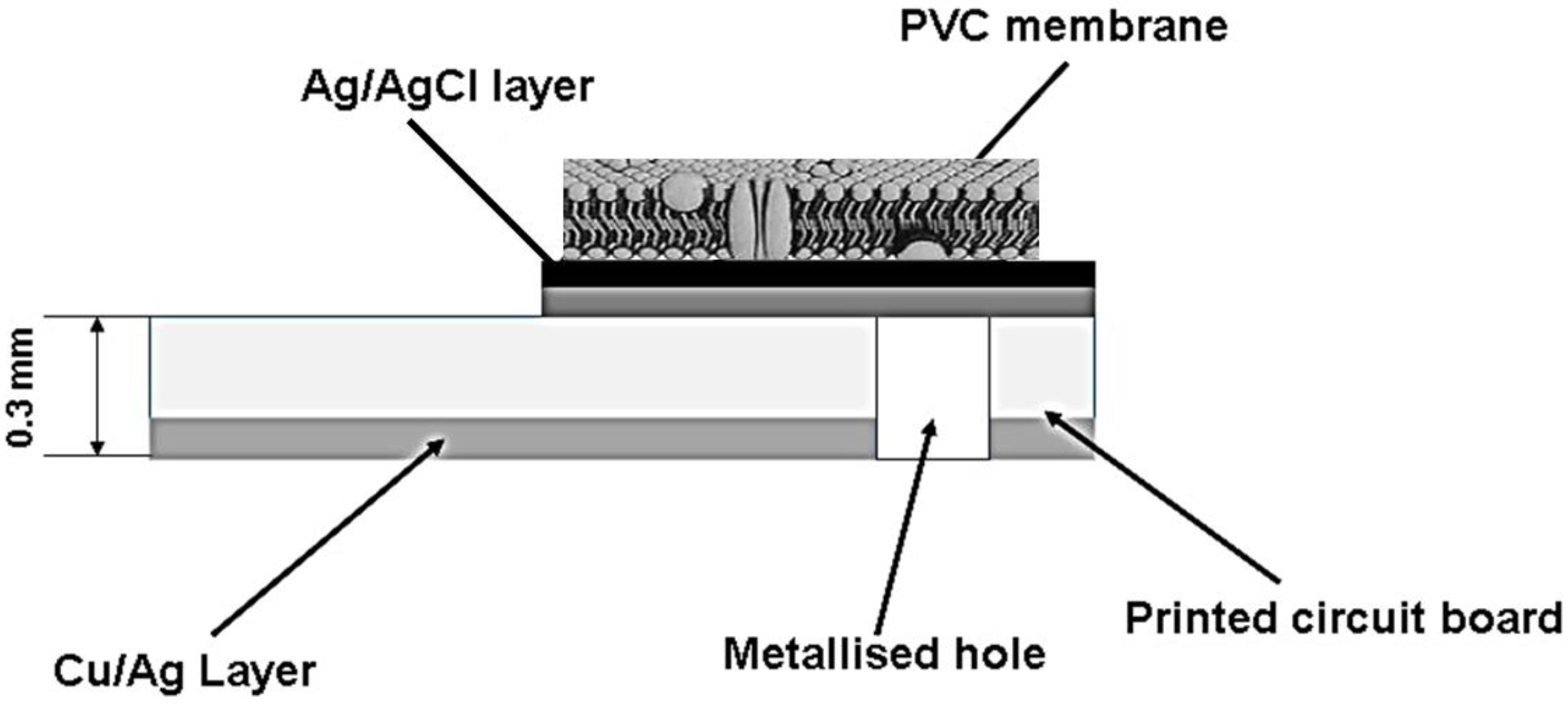
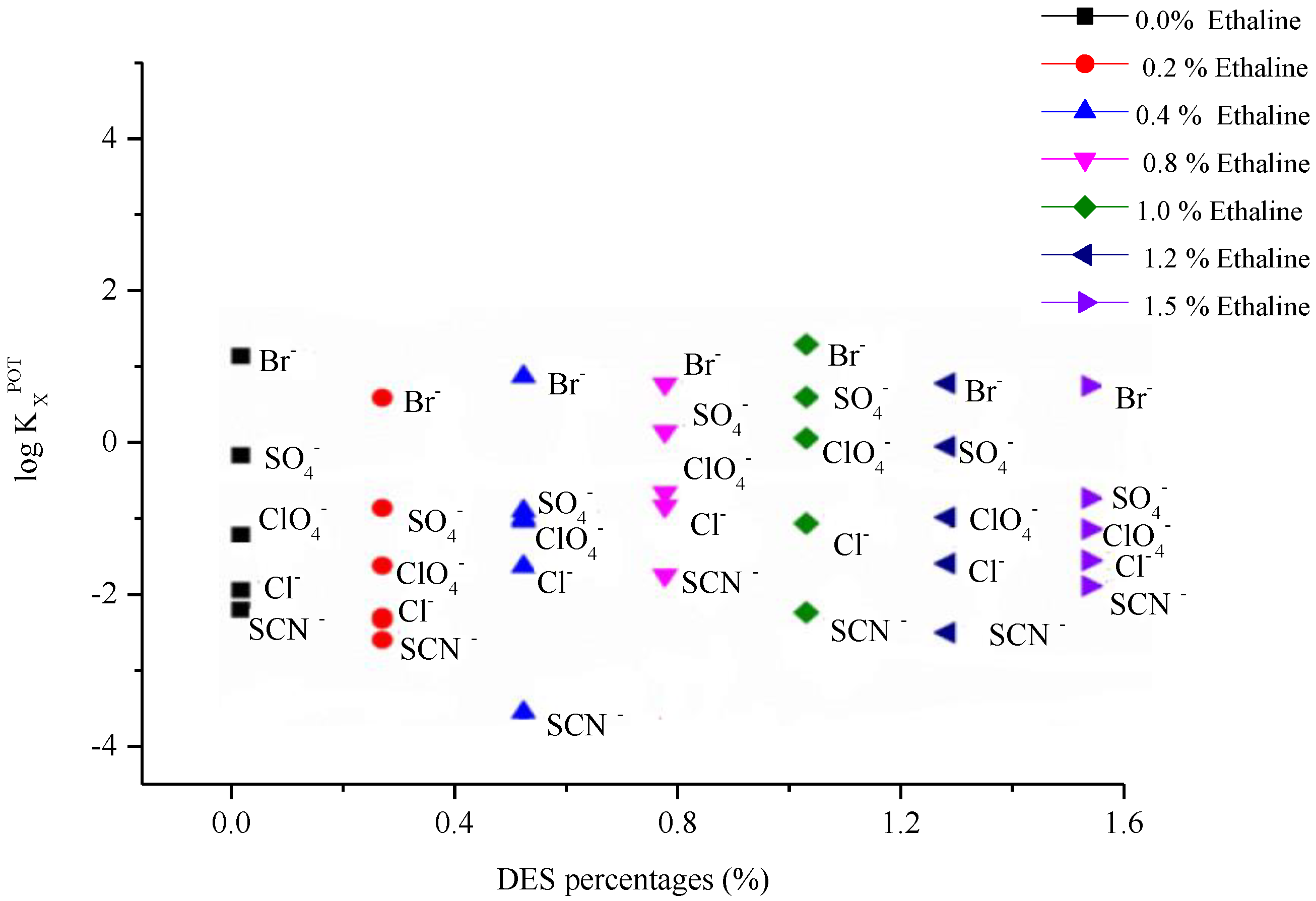

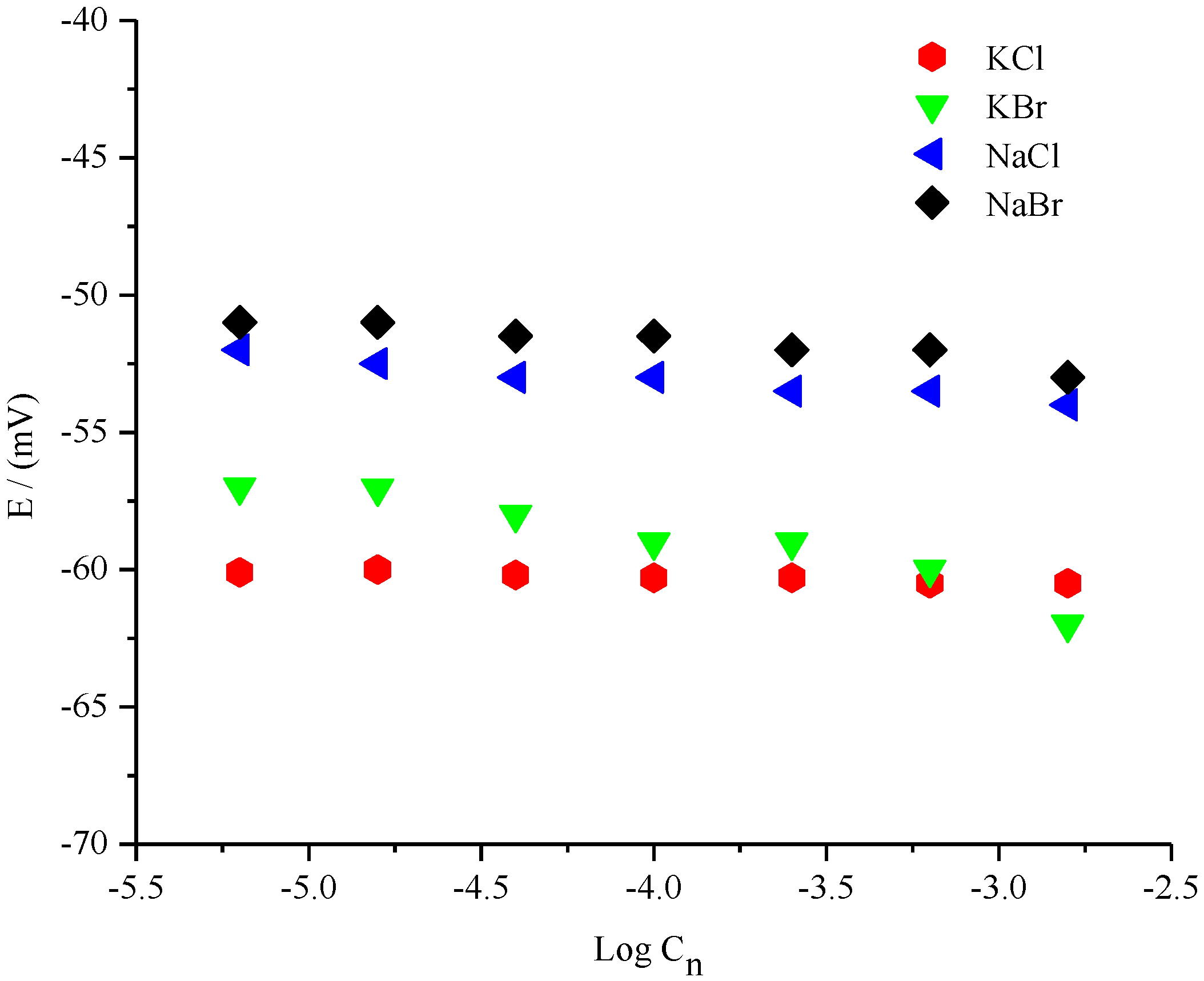
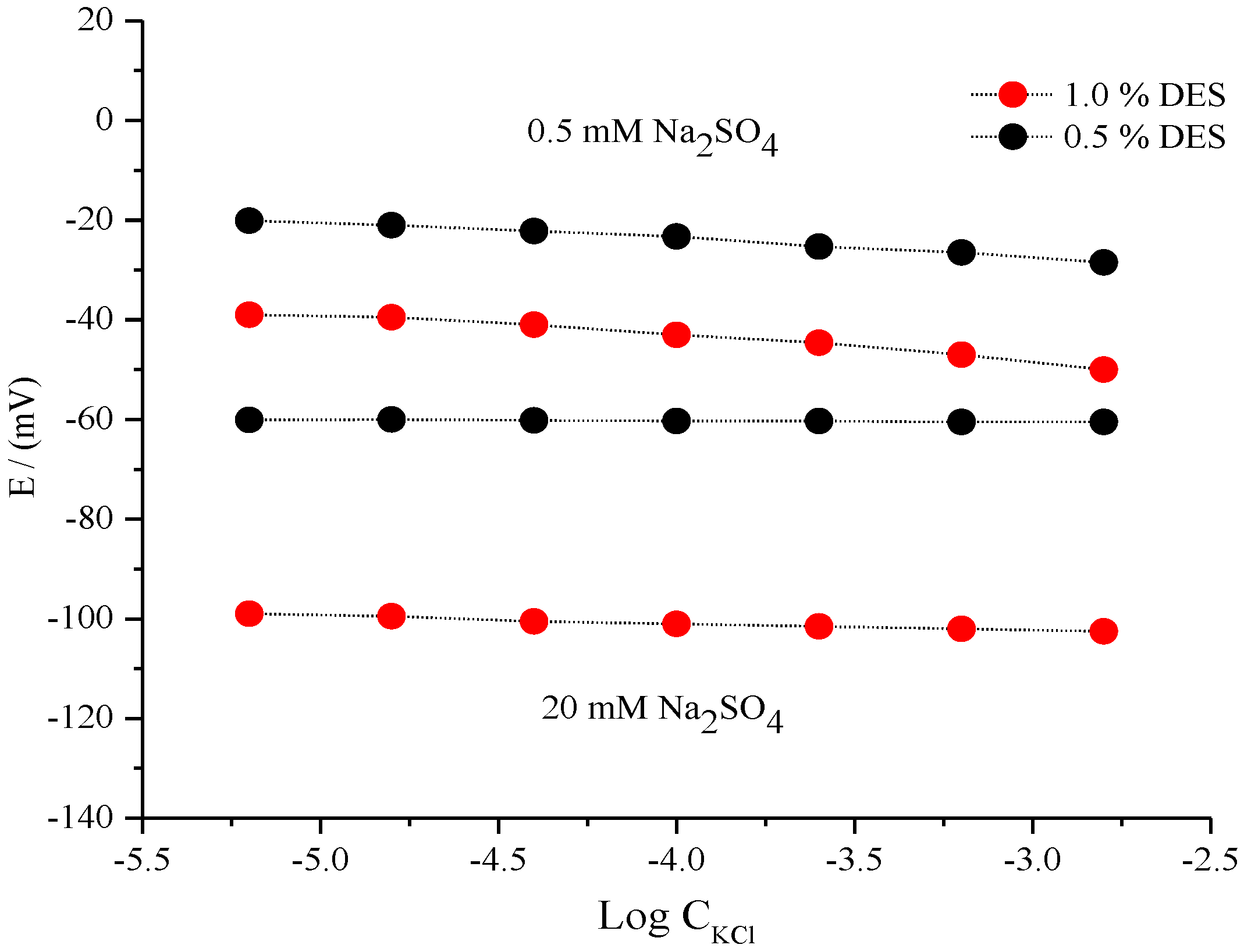
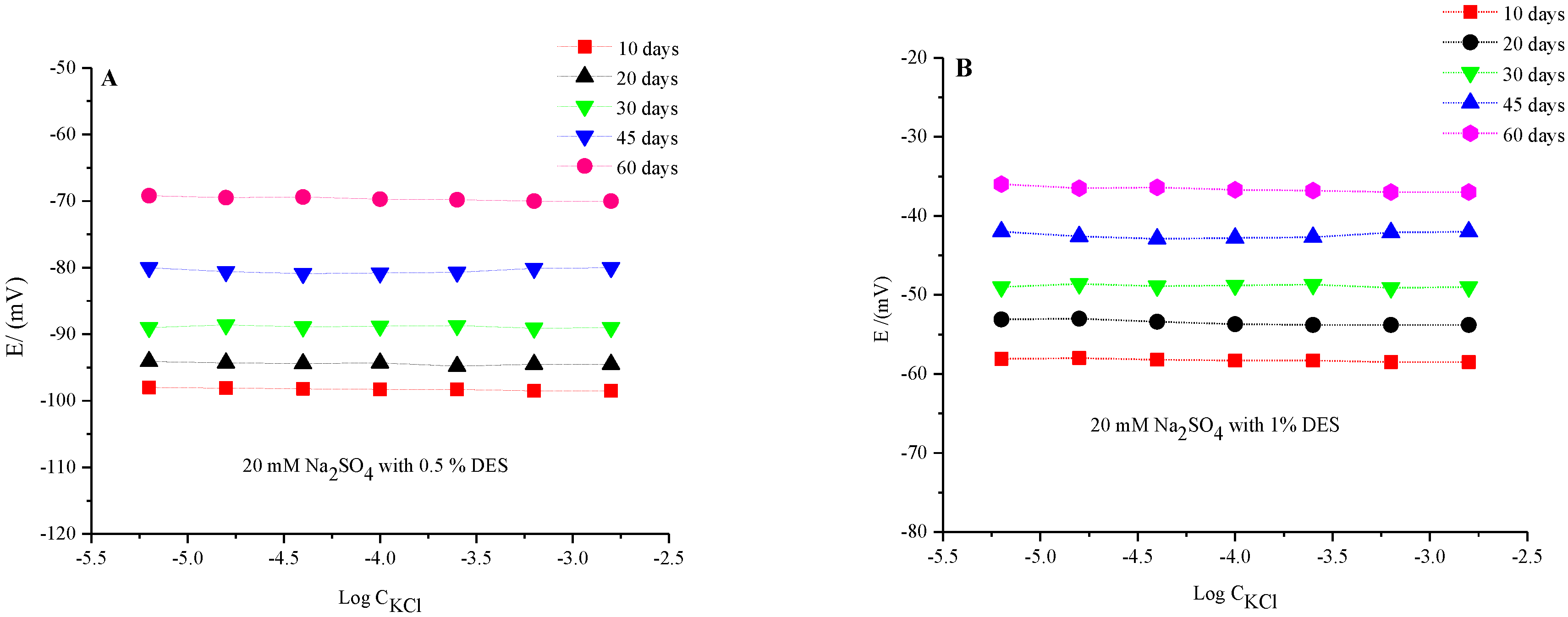
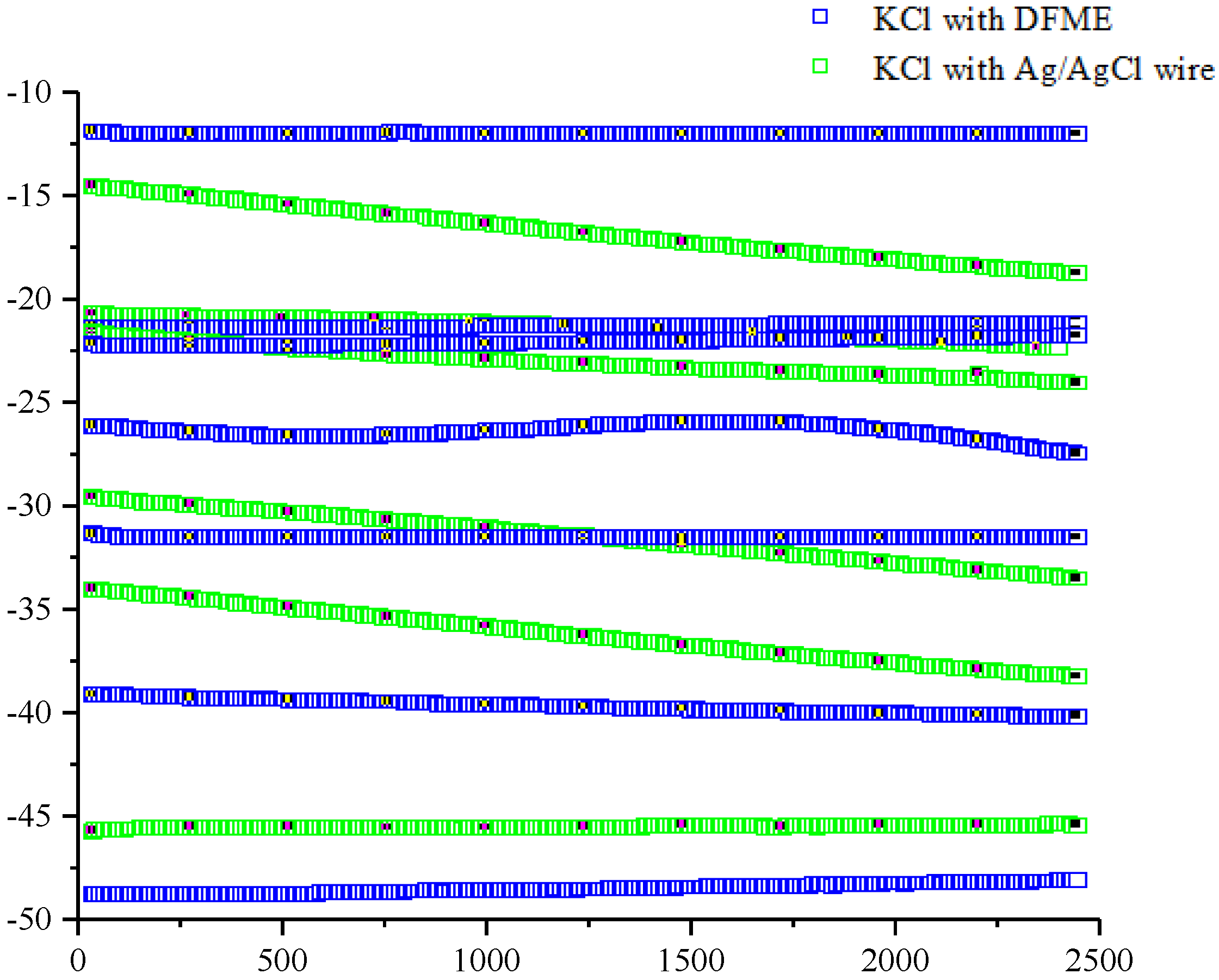
Publisher’s Note: MDPI stays neutral with regard to jurisdictional claims in published maps and institutional affiliations. |
© 2022 by the authors. Licensee MDPI, Basel, Switzerland. This article is an open access article distributed under the terms and conditions of the Creative Commons Attribution (CC BY) license (https://creativecommons.org/licenses/by/4.0/).
Share and Cite
Alabdullah, S.S.M.; Abass, A.M.; Salman, H.G. Deep Eutectic Solvents Enhance Stability of Ag/AgCl Solid State Miniaturised Reference Electrode. Chemosensors 2022, 10, 216. https://doi.org/10.3390/chemosensors10060216
Alabdullah SSM, Abass AM, Salman HG. Deep Eutectic Solvents Enhance Stability of Ag/AgCl Solid State Miniaturised Reference Electrode. Chemosensors. 2022; 10(6):216. https://doi.org/10.3390/chemosensors10060216
Chicago/Turabian StyleAlabdullah, Sahar S. M., Amina M. Abass, and Huda Ghalib Salman. 2022. "Deep Eutectic Solvents Enhance Stability of Ag/AgCl Solid State Miniaturised Reference Electrode" Chemosensors 10, no. 6: 216. https://doi.org/10.3390/chemosensors10060216





